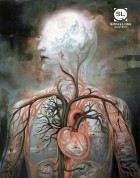When I first met Sherry she was standing barefoot in the tall grass feeding bread to a swan. Sherry lived on the other side of Stoney Creek in a small clapboard house that sat up on cinder blocks, overlooking the cove and bordering the woods that hemmed in the neighborhood. The swan had just appeared one day, she said, standing in front of her house, and it continued to visit because, well, it liked bread.
Sherry held out her hand.
The bird danced and spread its wings.
“Don’t come near him,” she said. “He only likes me.”
I didn’t know anyone else who had a swan in their yard, so I stayed friends with Sherry, despite my father’s stories about her parents, about how they were actually brother and sister but still lived together in the old house like they were married, and how they kept guns and would shoot anyone who stepped foot on their property uninvited.
“They’re hillbillies,” he said as if to distinguish our family by comparison.
We were not hillbillies. We were Catholics.
When the plumbing broke in Sherry’s house, her father redirected the pipe to empty into the creek, and though my father complained, Sherry’s father, who was head of the community board, said he could do what he wanted with his property.
Sherry and I didn’t mind. We continued to swim in the water all summer, jumping off the pier and diving to the cloudy bottom where we would grab fistfuls of the cold black mud, come up for air and throw the sludge at each other—sometimes smearing it on our bodies to keep cool. Then we would stand on the lawn to be hosed down. Our mothers would pop our blisters and inspect us for bugs. The cores of the blisters were hard and small, and they would shoot across the room and bounce off the walls. We would rub an ointment on our skin that stained it purple, and we stayed that color for weeks.
All the other children at school could tell that we lived on Stoney Creek because our skin was purple, and it meant we had bugs. But Sherry and I knew it was because we were best friends, and best friends stayed the same color.
The summer I turned eleven, the county brought in their heavy machinery and paved Solley Road so that it made an elegant black S-curve through the rows of pine and birch trees past the farmhouse on the main highway. The woods behind Sherry’s house were chopped down and hauled away on long flatbed trucks to make room for the new houses that were being built along the coves. More families began to move in, and by the end of the summer there were twice as many children swimming in Stoney Creek. They were all stained purple too, so then we sort of had a club.
I hadn’t seen the swan all summer, not since the county trucks had arrived, but one day I found Sherry sitting on the docks behind her house burning a minnow with a magnifying glass, and I asked her what had become of the great white bird.
Sherry looked at the space where the woods used to be as if he might appear there, and when he didn’t she shrugged her shoulders. “He went away,” she said.
That fall the school bus came down Solley Road for the first time, and we no longer had to walk to the main highway in the mornings. But the new driver hadn’t learned to maneuver the long yellow bus out of the narrow cul-de-sac where the road dead-ended at Sherry’s house. He had to back up and pull forward several times to turn around, and it took him forever, and one morning it was raining hard and the windows were fogged and streaked with gray, and the driver didn’t see Sherry when she stepped behind the bus.
I felt the jolt and heard the crunching sound when the wheels rolled over her body, and all the children on the bus groaned and cried and some of them got sick and no one went to school that day. And after the ambulance had gone there was a dark stain on the fresh macadam that even the rain couldn’t wash away.
Sherry’s parents moved out of the old house, and I rarely visited the other side of the cove after that. I never saw the swan again, but every morning when the bus would pick me up and drive to the end of the cul-de-sac to turn around, I would see the dark stain on the road and think of Sherry. And then I would think of the swan—how beautiful it had looked on the lawn that day with its wings spread wide. I’d wonder where it had gone and why.

Notes from Guest Reader Nickalus Rupert
‘Swans’ carries an off-kilter weirdness that works nicely. The narrative world is memorable and humorous without becoming too “jokey.” I’m especially fond of the friendship between the narrator and Sherry.


 The SmokeLong Grand Micro Contest (The Mikey) is now an annual competition celebrating and compensating the best micro fiction and nonfiction online.
The SmokeLong Grand Micro Contest (The Mikey) is now an annual competition celebrating and compensating the best micro fiction and nonfiction online.